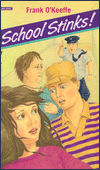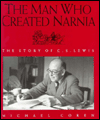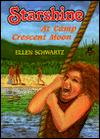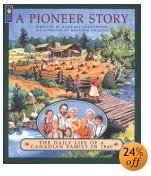Rosalie's Catastrophes

by Ginette Anfousse,
ISBN: 060609797X
School Stinks

by Frank O'Keefe,
132 pages,
ISBN: 077367294X
The Man Who Created Narnia:
The Story of C. S. Lewis

by Michael Coren,
151 pages,
ISBN: 0802838227
A Prairie Year

by Jo Bannatyne-Cugnet, Yvette Moore,
32 pages,
ISBN: 0887763340
Starshine at Camp Crescent Moon

by Ellen Schwartz,
160 pages,
ISBN: 0919591027
Dragon in the Clouds

by Rosemary Nelson,
160 pages,
ISBN: 0929141229
A Light in Space

by Wendy Orr, Ruth Ohi, Ruth Ohi,
124 pages,
ISBN: 1550373684
A Pioneer Story:
The Daily Life of a Canadian Family in 1840

by Barbara Greenwood, Heather Collins,
240 pages,
ISBN: 1550741284
Witches, Ghosts & Loups-Garous

by Joan Finnigan,
ISBN: 1550820869
Post Your Opinion | | Children's Books - The Lion, the Alien, and the Pioneers
by Allison SutherlandALTHOUGH, ALAS, THERE ARE NO new Narnia books, we can at least turn to The Man Who Created Narnia: The Story of C. S. Lewis (Lester, 152 pages, $24.95 cloth) by Michael Coren. This competent, readable biography is for those who are encountering Lewis's kingdom of talking beasts, nymphs, dryads -- and Aslan, the lion who created and redeemed it all. "So now I'll understand why he wrote the books the way he did," said our 10-year-old, which pretty well encapsulates what this book intends to do. There is a "Not in front of the children" flavour to some of it, notably on Lewis's difficulties with his father and his relationship (did he have an affair?) with Mrs. Moore, the mother of one of his friends. But this is not hagiography, and if our 10-year-old is still interested in a few years, he will find that the grimier details of Lewis's life as revealed by other biographers will not invalidate what he has read here. Lewis's exasperating, enduring charm comes across well, as does his quite startling goodness. This is also one of the few biographies in which his wife, Joy Davidman, comes across as being even halfway attractive. When discussing Lewis's work, however, Coren assigns the plot of The Magician's Nephew to Prince Caspian. And I was surprised to find Till We Have Faces mentioned only in the bibliography; along with Out of the Silent Planet, this adult novel is very accessible for adolescents.
Lewis's gifts are not evident in three horribly typical "realistic" novels for female pre-adolescents: Dragon in the Clouds (Napoleon Publishing, 159 pages, $14.95 paper) by Rosemary Nelson; Nancy Nylen: Ordinary Farm Girl, Explorer Extraordinaire (Beach Holme, 197 pages, $5.95 paper) by Frank O'Keefe; and Starshine at Camp Crescent Moon (Polestar, 142 pages, $8.95 paper) by Ellen Schwartz. They make depressing reading. In North America there is a generic, interchangeable first-person protagonist for such works, and here she is, respectively, Nikki, Nancy, and Starshine. Each shows dreary artificial sprightliness in lieu of individuality. When reading this stuff, one longs for the individuality of an Adrian Mole, an Angela of TV's "My So-Called Life," or perhaps a Caroline of Robertson Davies's The Manticore, of whom he says "... Caroline was twelve, and in that queer time between childhood and nubile girlhood, when some girls seem to be wise without experience, and perhaps more clearheaded than they will be again until after their menopause." One longs in vain.
In Dragon in the Clouds I knew what I was in for on the first page when I read, "Some kids hate the idea of school ending for two months, but not me!" My worst fears became justified by pasteboard parents, an implausible plot, and, distastefully, a paraplegic cousin brought in to provide a social issue. Fortunately, this book is so obviously inept that no child will waste much time with it.
Nancy Nylen, marginally more interesting, provides an enjoyably accurate rural setting, some last-minute assembly-line pie-baking for a church social, and the disposal of a bunch of killer bantam chickens. But O'Keefe has braided his rural material with two other unsuccessful strands: a plot involving some match making for a teacher, and a nonsensical adventure novel penned by his protagonist. These elements might have been used to inform and reflect each other. Instead, they give the impression of three distinct entities that have been dumped in together because none separately could make a full-length book.
An account of a first time at camp, Starshine at Camp Crescent Moon tries hard, usually in vain, except for a reasonably evocative account of illicit skinny dipping by moonlight ("The water feels wetter...") and a character who has cerebral palsy and displays the marvellous goofy black humour often exhibited by those who have this disability.
It was an enormous relief to plunge into A Light in Space (Annick, 188 pages, $4.95), by Wendy Orr. This is top-quality science fiction, ringing the changes on one of the time-honoured plots of the genre: an extra-terrestrial sets up communication with an earth-child, possibly with a view to taking over the planet. Orr has a lot of fun with alien perceptions of our culture; the family dog is referred to as "the mobile black hole" after it is observed eating a chocolate bar, and parents as "the big ones that cause trouble." Her young hero, Andrew, has some nice lines too, as in the description of a doctor's waiting room, where "all the magazines seemed to be about the royal family, dieting, and chocolate cake." Best of all is the quite masterly creation of an alien mind-set and value system, the sine qua non of good SF.
Rosalie's Catastrophes (Ragweed, 93 pages, $5.95 paper) is a frisky little number from the capable pen of Ginette Anfousse. It has been ably translated by Linda Gaboriau, who has managed to transmit the flavour of Montreal and the attractive battiness of certain types of Quebecoises. Rosalie is an orphan and lives with her seven devoted aunts, each of whom approaches child-rearing idiosyncratically. Rosalie, understandably, is given to exclaiming "Holy hopping horrors!" at intervals. I'd love to know what this is in the original French. Anyway, this is great stuff. It will be fun to see what comes next in the series.
Folk material from the Ottawa Valley, Witches, Ghosts and Loups-Garous (Quarry, 83 pages, $14.95 cloth), has been retold not terribly well by Joan Finnigan, and illustrates the fact that emotional impact often comes from style rather than content. "This book is kind of average," commented our house expert on the supernatural. "Not that scary. Not that exciting." Some of it does manage to transcend the writing, notably a section on Alice Snowshoes, who was abandoned in her old age by her tribe, adopted by whites, and used her powers as a medicine woman to help and heal. Finnigan is apt to lessen the impact of the stories still further by prefacing them with comments such as "Here's a weird tale ..." or "This terrifying story."
Jo Bannatyne-Cugnet and the illustrator Yvette Moore have followed the success of A Prairie Alphabet with A Prairie Year (Tundra, 32 pages, $17.95 cloth). The text is wonderfully authentic on such matters as hockey practice in January, getting ready for new chicks in April, and trick-or-treating by car on Hallowe'en. At first glance this is a ravishing item, as most of Tundra's productions are, and communicates an almost mythic sense of glorious rural life. Upon examination, however, flaws in the illustrations spoil one's enjoyment. The foreshortening of the hockey players apparently depicts a team of achondroplastic dwarfs, a litter of ostensibly newborn piglets looks at least six weeks old, some Clydesdale horses are quite the wrong shape and colour, and most heinous of all, the Hallowe'en illustration shows the trick-or-treaters in broad daylight when the text specifically emphasizes waiting for nightfall. Let us hope for more books from this team, but let us also hope that Ms. Moore will be a little more careful in future; the charm of hyper-realism lies in meticulous accuracy.
Barbara Greenwood's A Pioneer Story (Kids Can, 240 pages, $ 16.95 cloth), illustrated by Heather Collins, is a first-class mix of fiction and fact, text and illustration. Making soap, finding honey, spinning and dyeing wool -these and many other elements of pioneer life are described, sometimes by means of stories about a fictional family of 1840, often linked with instructions on how to perform related activities. The book is endlessly interesting, has a sense of charm and atmosphere (a chapter on finding a bee tree is especially attractive), and somehow makes its characters (particularly the sullen teenaged son) perfectly three-dimensional. Not often does a book attempt -- and achieve -- so much on so many fronts. One quibble. Greenwood states that pioneers used corncobs to wipe themselves after using the outhouse. This does sound unlikely. And painful.
A sound biography of a great children's writer. A rising SF star. A tasty slice of Quebecois life. And a fine book of do-it-yourself pioneering. Four for the read. |